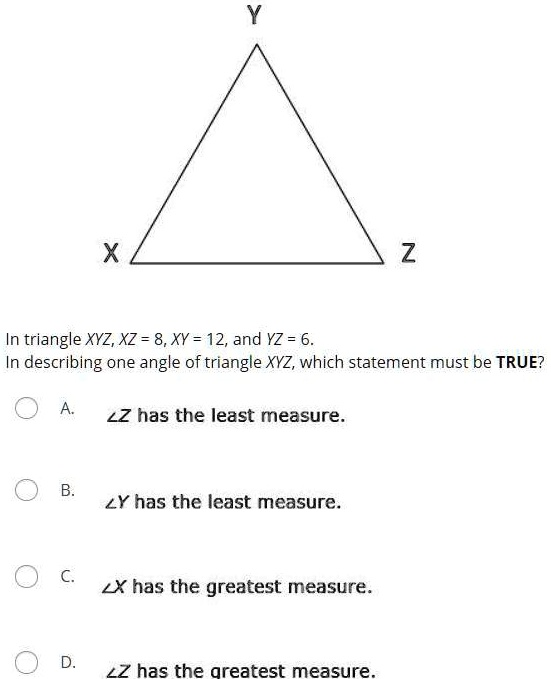triangle XYZ, which statement must be TRUE? A. ?Z has the least measure. B. ?Y has the least measure. C. ?X has the greatest measure. D. ?Z has the greatest measure.
In triangle XYZ, XZ = 8, XY = 12, and YZ = 6. In describing one angle of triangle XYZ, which statement must be TRUE? A. ?Z has the least measure. B. ?Y has the least measure. C. ?X has the greatest measure. D. ?Z has the greatest measure.

The Correct Answer and Explanation is:
The correct answer is D. ∠Z has the greatest measure.
To understand why, we can apply a fundamental geometric principle: in any triangle, the angle opposite the longest side has the greatest measure, and the angle opposite the shortest side has the least measure.
Given:
- XZ = 8
- XY = 12
- YZ = 6
Now match each side to the angle directly opposite it:
- Side XY (length 12) is opposite angle ∠Z
- Side YZ (length 6) is opposite angle ∠X
- Side XZ (length 8) is opposite angle ∠Y
Among these, the longest side is XY = 12. Therefore, the largest angle must be ∠Z because it is directly opposite this side. Likewise, the shortest side is YZ = 6, meaning ∠X must be the smallest angle.
This conclusion aligns with the Law of Opposites in triangle geometry. Longer sides stretch further, which causes the opposing angles to open wider. Conversely, shorter sides restrict the opposing angles and keep them narrow. Though you could use the Law of Cosines to calculate exact measures, it is unnecessary here because the relative comparison of sides provides all the information needed.
Hence, without ambiguity, the statement that must be true is that ∠Z has the greatest measure. Every triangle behaves this way regardless of orientation, because the internal angle measures depend only on the lengths of the opposing sides. This property is essential in applications such as trigonometry, architecture, and structural analysis, where understanding the behavior of shapes under constraints informs critical design decisions.
